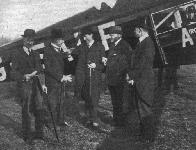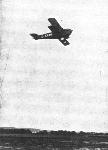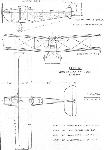
Описание
Страна : Великобритания
Год : 1920
Легкий пассажирский самолет с одним пилотом
Варианты
- De Havilland - D.H.18 - 1920 - Великобритания
- De Havilland - D.H.32 / D.H.34 - 1921 - Великобритания
- De Havilland - Highclere / D.H.54 - 1925 - Великобритания
de Havilland DH.18
Обозначение DH.18 присвоили большому одномоторному биплану, вмещавшему восемь пассажиров в закрытом салоне. Пилот размещался в открытой кабине за бипланной коробкой. Построенный в Хендоне DH.18 впервые взлетел в феврале 1920 года и был продан авиакомпании "Aircraft Transport & Travel Ltd." для полетов на линии Кройдон - Париж. Однако прослужил он недолго и разбился при вынужденной посадке у Кройдона в августе того же года.
В 1920 году компания "Airco", строившая самолеты де Хэвилленда, сменила название на "de Havilland Aircraft Co. Ltd.". Новая фирма построила два модифицированных самолета DH.18А для компании "Instone Air Line", которая позже приобрела третий самолет того же типа. Все они летали на континентальных авиалиниях. Первый аэроплан был списан в сентябре 1921 года; другой разбился всего через два месяца после поставки. Третий экземпляр, поставленный в июне 1921 года, в апреле 1922-го перепродали компании "Daimler Hire Ltd.". Несколько дней спустя он разбился, столкнувшись в небе над Францией с бомбардировщиком "Farman Goliath".
Последние два самолета обозначили DH.18B. Они имели фюзеляжи с фанерной обшивкой вместо полотна. Их масса возросла до 1955 кг, а максимальная взлетная - до 3228 кг. Эти машины недолго прослужили в компании "Instone". Второй аэроплан разобрали в 1923 году. Первый использовался в испытаниях Министерства авиации на плавучесть с преднамеренной посадкой в Северном море у Феликстоу, Саффолк, в мае 1924 года. Странно, но последним уцелевшим самолетом DH.18 стал первый серийный самолет, поставленный в центр RAE для испытаний после списания из компании "Instone" в 1921 году. Его сдали на слом в 1927 году.
ТАКТИКО-ТЕХНИЧЕСКИЕ ХАРАКТЕРИСТИКИ
de Havilland DH.18A
Тип: легкий пассажирский самолет с одним пилотом
Силовая установка: W-образный поршневой мотор Napier Lion мощностью 450 л. с. (336 кВт)
Летные характеристики: максимальная скорость 206 км/ч на оптимальной высоте; крейсерская скорость 161 км/ч на оптимальной высоте; начальная скороподъемность 201 м/мин; практический потолок 4875 м; дальность полета 644 км
Масса: пустого самолета 1833 кг; максимальная взлетная 2956 кг
Размеры: размах крыльев 15,62 м; длина 11,89 м; высота 3,96 м; площадь крыльев 57,71 м2
Полезная нагрузка: до восьми пассажиров либо груз
Описание:
- de Havilland DH.18
- Flight, March 1921
THE D.H. 18 LIMOUSINE
Фотографии
-
Aeroplane Monthly 1987-05 / J.Stroud - Wings of Peace
Регистрационный номер: G-EARI [7] 8 апреля 1920г.: первый построенный в начале года в Хендоне самолет de Havilland DH.18 (рег. G-EARI) британская авиакомпания "Air Transport & Travel" начала эксплуатировать на линии Кройдон - Париж. Самолет разбился 16 августа 1920г. в районе аэропорта Кройдон.
На фото: G-EARO - первый серийный DH.18, использовавшийся авиакомпаниями AT&T и "Instone" и закончивший свои дни в испытательном центре RAE в фарнборо.
The prototype D.H.18 G-EARI in original form with two-bladed propeller. -
Aeroplane Monthly 1987-05 / J.Stroud - Wings of Peace
Регистрационный номер: G-EARI [7] AT&T's D.H.18 G-EARI. The cut-back rudder horn is clearly visible.
-
Aeroplane Monthly 1974-01 / P.Moss - Wings for the Empire (1)
Регистрационный номер: G-EARI [7] The D.H.18 G-EARI carried eight passengers and is doped in the blue and silver livery of AT&T. Types was powered with the 450 h.p. Napier Lion.
-
Aeroplane Monthly 1987-05 / J.Stroud - Wings of Peace
Регистрационный номер: G-EARI [7] THE OPENING OF WADDON AIR PORT: The new Airco 18, 450 h.p. Napier Lion engine, ready to commence work on the London-Paris air service. This machine has a different seating accommodation from previous types, the pilot being placed far back in the fuselage, behind the cabin, which seats eight passengers. A three-bladed propeller is fitted.
The prototype D.H.18 at Croydon during 1920. It had a three-bladed propeller and cutback rudder horn balance. -
Aeroplane Monthly 1987-05 / J.Stroud - Wings of Peace
Регистрационный номер: G-EAUF [4] D.H.18A G-EAUF in Instone service, at Croydon. The block lettering of the registration was probably unique.
-
Flight 1920-10 / Flight
Регистрационный номер: G-EAUF [4] AIR CONFERENCE VISIT TO WADDON: Airco 18, Instone Vickers Vimy-Commercial, Westland Limousine, Avro triplane, and Bristol Coupe
Другие самолёты на фотографии: Avro Type 547 - Великобритания - 1920Bristol Tourer - Великобритания - 1919Vickers Vimy Commercial - Великобритания - 1919Westland Limousine - Великобритания - 1919
-
Flight 1920-10 / Flight
AIR CONFERENCE VISIT TO WADDON: Our group shows: Mr. Bonar Law, Lord Weir, General Sykes, Sir James Stevenson, and General Ellington, with one of the Airco machines as a "background"
-
Flight 1921-04 / Flight
Регистрационный номер: G-EAUF [4] ARRIVED FROM PARIS: Passengers alighting from the "D.H.18 G-EAUF" of the Instone Air Line at the Croydon terminal.
-
Flight 1921-06 / Flight
Lord Leverhulme Uses London-Paris Air Route: Our picture shows Lord Leverhulme descending from the Instone D.H.18 (Napier "Lion"), which is doing such good service on the London-Paris Air route. Lord Leverhulme constantly travels to and from the Continent by air.
-
Aeroplane Monthly 1987-05 / J.Stroud - Wings of Peace
The centre fuselage and passenger entrance door of the prototype D.H.18.
-
Aeroplane Monthly 1987-05 / J.Stroud - Wings of Peace
This view of the D.H.18 cabin shows the forward-facing seats to starboard and the rear aft-facing seat to port.
-
Aeroplane Monthly 1987-05 / J.Stroud - Wings of Peace
Регистрационный номер: G-EARI [7] The prototype D.H.18 in AT&T livery but without wing registration.
-
Aeroplane Monthly 1977-12 / Personal album
Регистрационный номер: G-EARI [7] G-EARI was the prototype D.H.18, and flew with Aircraft Transport & Travel Ltd. for only a short period. On August 16, 1920, it crashed into some gardens in Wallington after experiencing engine trouble coming out of Croydon.
-
Flight 1920-06 / Flight
OFF TO PARIS: One of the Napier-engined Airco 18 machines recently flew from London to Paris in 1 hour 47 minutes, with seven passengers on board. The machines are designed to carry eight passengers in addition to the pilot. Fitted with a Napier Lion, one of these machines is capable of climbing to 10,000 ft. in 20 minutes with its full complement of passengers. As the cabin is entirely closed in, it is possible to fly in absolute comfort, even at the great speed reached by the Airco 18, and it is therefore only natural that this machine is getting very popular on the Continental Air Express Service
-
Aeroplane Monthly 1987-05 / J.Stroud - Wings of Peace
Регистрационный номер: G-EAWX D.H.18B G-EAWX, the last D.H.18 built, in Instone livery' at Brussels. The fuselage aft of the engine firewall was completely ply covered.
-
Flight 1921-03 / Flight
View inside the cabin of the D.H.18.
-
Aeroplane Monthly 1987-05 / J.Stroud - Wings of Peace
Регистрационный номер: G-EAUF [4] KEITH WOODCOCK'S painting shows the Instone D.H.18A G-EAUF and the D.H.17 as it would have appeared in the livery of Aircraft Transport & Travel.
Другие самолёты на фотографии: De Havilland D.H.17 - Великобритания - 1919
-
Flight 1921-03 / Flight
Pictorial diagram of passenger accommodation, etc., in the D.H.18.
-
Flight 1921-03 / Flight
THE D.H.18: The engine unit is detached by undoing a few bolts in the four corners. The lower sketch shows the fitting in the lower starboard corner.
-
Flight 1921-03 / Flight
THE D.H.18: From left to right the sketches show: Ball-and-socket joint attachment of telescopic undercarriage strut to lower longeron. Detail of the rubber shock-absorber arrangement. Attachment of struts to wheel axle.
-
Flight 1921-03 / Flight
D.H.18 450hp Napier 'Lion' engine
- Фотографии





















